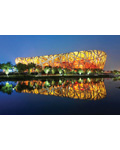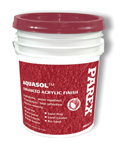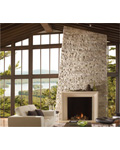Manufactured Techniques for Architectural Colors and Textures
An example is Brazilian rosewood, a strong, dense, and oily wood that weighs about 53 pounds per cubic foot, according to woodworking expert Lee Swindel, but is endangered and cannot be sold internationally. “Brazilian rosewood has natural oils that prevent water absorption and make it resistant to insects and decay,” according to Swindel, one reason that the wood has been favored for everything from wine barrels to furniture to classical guitars.
Overuse of the species has depleted most of the straight-growing trees that produce the high-quality lumber needed for these uses. Of the few that are left, in fact, a portion is protected from harvest in a global bid to save the species. In the absence of new sources, recently the reclaimed rosewood from wine barrels has been fashionable as flooring in restaurants, costing hundreds of dollars per square foot to procure and install.
Demand is high, but with resources very limited several manufacturers have created faux rosewood lookalikes in laminate, ceramic tile and other unexpected materials.
“Many advances have been made in the development of flooring materials,” says Katie Grimwood, an interior architect with TowerPinkster Architects | Engineers, Grand Rapids, Mich. “Manufacturers have made great strides in digital printing on ceramic, porcelain, and vinyl substrates. For instance, wood visuals can be applied to tile products in high traffic areas, blending the warmth and depth of wood with the durability of tile.”
Another technique that has opened new possibilities is digitally printed wall coverings, says Grimwood. “These products add color, texture, and branding very easily to large wall areas. These kinds of processes allow greater flexibility in the selection of materials that offer particular physical properties and also, through new technology, offer a greater variety of colors, textures and appearance.”
Turning Materials on Their Heads
With the architectural palette expanding but many natural resources shrinking, architects are availing themselves of an expanding array of faux finishes in recent years. Examples include stucco finishes that are smooth rather than rough textured, as well as facsimile brick and granite rendered in EIFS or stucco for use on walls indoors and outdoors.
These kinds of simulated finishes often look real enough, but thanks to their material properties can be used in unlikely applications. The use of EIFS and manufactured stone finishes indoors is one example, just as others use high-pressure laminate or large-format ceramic tiles on exterior façades. Where building codes and common sense allow, architects are even applying ceiling and flooring materials to walls, columns and other vertical surfaces.
“Patterns that are typically applied horizontally can be used vertically or on an angle, for a completely different and successful look,” says The Architectural Team's Orlando.
Another trend in recent years has been the use of more sophisticated, contemporary colors and textures where traditional looks have prevailed. For example, says Eldorado Stone's Spann, “Interior applications of natural and manufactured stone, especially in the commercial sector, are tending toward more modern styles, with a recent resurgence of use of Frank Lloyd Wright's linear stones.” The look is best exemplified by Wright's 1936 masterpiece Fallingwater in Bear Run, Pennsylvania, which used the latest technologies to take his ideas of organic architecture to their aesthetic limits. The towers of stacked shale, rising through the cantilevered floors, evokes the natural beauty of the rocky site while providing a strong visual anchor for the seemingly floating planes.
The look is powerful and quite hard to achieve at a reasonable cost for the majority of homeowners. Sensing an opening, manufacturers have recreated cast-stone representing stacked shale and other stone combinations into panelized sections in a variety of lengths and heights. The panels require no grout, to create a more faithful reproduction of the modernist stacked-stone walls, in light color palettes like Fallingwater as well as dark, slate like tones.
Another design conceit that has recently seen a rebirth from its modernist roots is the use of more monochromatic material palettes, both on building facades and in commercial interiors. The trend seems to extend the popularity of neutral colors to have even more subtlety and—thanks to the more monolithic look—added drama and intensity. It also sets the stage for contrast: “A single strong color can be powerful in an otherwise neutral context,” says SmithGroupJJR's Shockey. “Nonrepeating and organic textures have great potential to be explored.”
Spann and other manufacturing authorities have noted a growing investment in product development and raw materials that respond to the more monochromatic and neutral palettes favored by many architects today. Instead the color depth is more subdued, today's projects employ warm grays and warm light neutrals on the one hand, as well as a range of deep charcoals, maroons and other darker neutrals on the other. At either end of the spectrum, the palettes tend to be monochromatic and warm ranges.
Along with these color choices, recent trends in texture have been increasingly subtle and smooth, many with unique visual properties. An example is the use of iridescent, pearlescent and opalescent optical and textural ingredients, which emerged in the late 1970s in the cosmetics industry. Pearlescent or “pearlized” pigments are coated with such additives as colored pure white mica or colored bismuth oxychloride, among others. In the cosmetic industry, however, finer pearlized particles are common, ranging in size from 3 to 25 microns; for architectural finishes, the particles range from 25 to 100 microns and larger.
Notice

www.laminart.com

www.parex.com

www.eldoradostone.com









